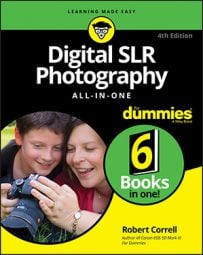Categories of digital SLRs
Not all digital SLRs are the same. It helps to organize them into broad categories based on features and prices. This is how they are designed and built, anyway. Manufacturers target specific audiences with each camera they produce. Knowing this helps you compare apples to apples when shopping or studying a camera’s capabilities.
- Consumer-level: These cameras are for beginners or those with a limited budget. Prices are under $1000, give or take. While they can take great photos, entry-level models at the low end of the consumer spectrum have limited features and capabilities compared to the rest. More expensive cameras in this category feature better performance and features and are very good cameras.
Don’t ever be embarrassed at having a consumer or entry-level dSLR. Even the least expensive dSLR is a far more capable camera than a compact digital. The best way to get more out of a consumer-level dSLR is to upgrade the lens.
- Mid-range models: These cameras are for the photo enthusiast who really means business. They range in price from between $1,000 and $1,500. Manufacturers begin adding pro-level features such as better autofocus, metering, and flash options. Mid-range models also cater to professional who needs something smaller, lighter, and less expensive than a top-tier camera.
- Professional cameras: dSLRs that cost over $1,500 are considered professional cameras. They are larger than amateur cameras, weigh more, use more magnesium alloy for strength and durability, and have many more features. The least expensive professional dSLRs often have cropped sensors and other form-factor compromises that help keep them affordable. High-end professional digital SLRs can run anywhere from $2,500 to $7,000 or more. They weigh more, are more durable, have the full-frame best sensors, image processors, autofocus, metering, and ISO performance than other dSLRs. They represent the pinnacle of digital SLR photography.
Basic parts of a digital SLR
All dSLRs share several common design elements, which makes it possible to pick up any dSLR and not feel totally lost. The following illustrations of a consumer-level model dSLR from Canon depict the basic parts of a typical dSLR.
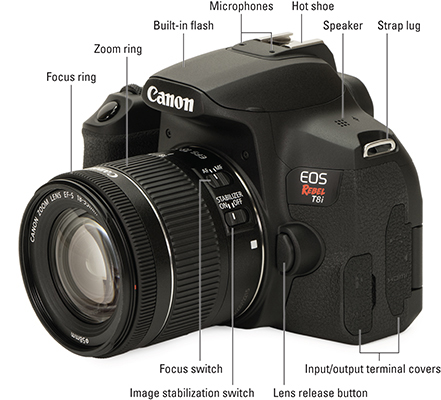
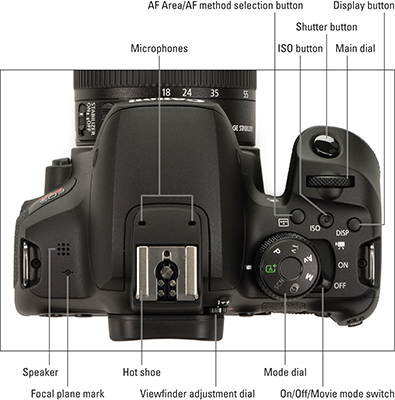
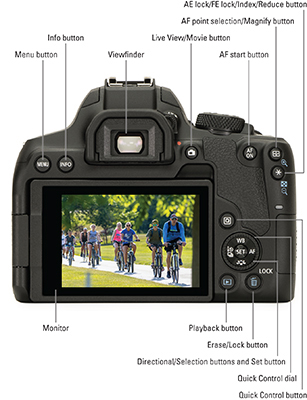
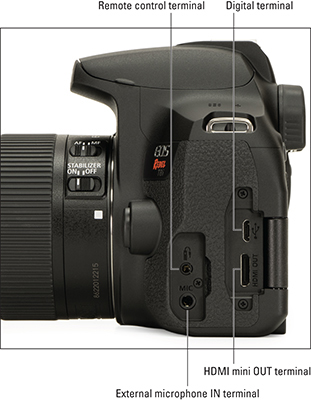
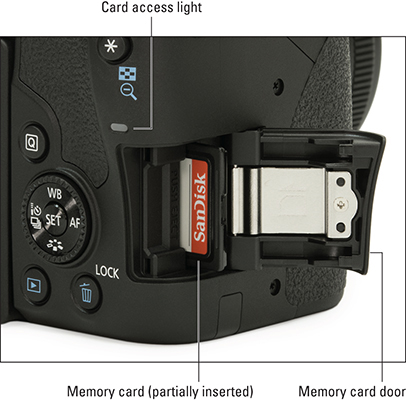
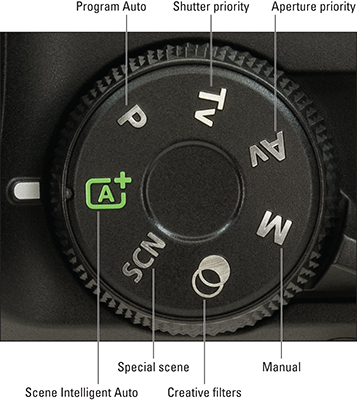
Digital SLR lens types and focal lengths
Lenses are an important part of digital SLR photography. Knowing what types of lenses there are and what they do will help you choose the right lenses for the type of photography you want to pursue.
The general lens categories are as follows:
- Zoom lenses: These lenses have a zoom ring that enables you to change focal length. They come in several types. General-purpose zoom lenses, also called standard zoom lenses, are versatile, with wide-angle and limited telephoto focal lengths. There are also wide-angle and telephoto zoom lenses.
- Prime lenses: These have a fixed focal length, which means that they don’t zoom in or out. While that might sound bad, prime lenses are very good at what they do. Buy the lens that matches the focal length you like the best. When you compose your shots, move closer or further away to zoom in and out.
- Macro lenses: Macro lenses specialize in taking extreme close-ups. Most macro lenses are primes.
- Other specialty lenses: This includes creative and artistic lenses such as:
- LensBaby: Non-traditional but creative. There are several models that have different creative focus and depth-of-field effects.
- Holga: A plastic Holga lens that is compatible with your dSLR and can be mounted directly. Awesome!
- Diana+: Like Holga lenses, but appear more zoomed. Requires an adapter.
- Tilt-shift: These tilt and shift, producing interesting depth-of-field and perspective effects.
- Pinhole: A pinhole that lets light into the camera. There is no optical element and no need to focus. The aperture is so small that the depth of field is huge. Expect longer exposure times. Pinhole cameras create soft dreamy photos.
Lenses are also categorized based on their focal lengths:
- Ultra-wide angle: These lenses have a very wide angle of view. Their focal lengths are 20mm and below for full-frame cameras, 15mm and below for APS-C, and 10mm and below for Four Thirds system dSLRs.
- Wide-angle: Wide-angle focal lengths include from approximately 20-40mm for full-frame, 15-25mm for APS-C, and 10-20mm for Four Thirds cameras.
- Normal: Normal focal lengths have the same basic perspective as the human eye. Focal lengths include 40-60mm for full-frame, 25-40mm for APS-C, and 20-30mm for Four Thirds cameras.
- Near (also known as medium) telephoto: Near telephoto focal lengths run from approximately 60-200mm for full-frame cameras, 40-135mm for APS-C, and 30-100mm for Four Thirds system cameras.
- Telephoto: This range is considered “proper telephoto.” It extends from the end of near telephoto and stops just before things get outrageously expensive. Typical telephoto focal lengths are from 200-300mm for full-frame, 135-200mm for APS-C, and 100-150mm for Four Thirds cameras.
- Super telephoto: These lenses are singularly optimized to shoot incredible shots with ridiculous focal lengths. They run from 300mm and up on full-frame cameras, 200mm and up for APS-C, and 150mm and up for Four Thirds cameras.
Common digital SLR shooting modes
Choosing the right shooting mode is an important part of photography. There really isn’t a “wrong” choice here. Some people prefer to let the camera handle most of the work. Others prefer exercising more creative control.
| Name | Description |
| Automatic | This mode probably needs the least explanation. You point the camera. You press the shutter button halfway to focus, and then fully to take the photo. The camera does the rest. Simple.
Use when you’re learning about your camera and photography or when you need to transfer the workload to the camera so you can relax and have fun. Some cameras have more than one automatic mode, one of which will be “advanced.” |
| Flash Off | This mode is Auto without the flash. It may even be called Auto (flash off) on your camera. Easy. Use it when you want to be in Auto but can’t turn off the flash. |
| Portrait | Take photos with nicely blurred backgrounds and sharp subjects. May be in Scene or Special scene mode. |
| Landscape | For shots full of scenery, processed to make the colors stand out. Use Landscape mode to photograph cityscapes as well as traditional shots of nature. May be in Scene or Special scene mode. |
| Sports/Action | Optimized to photograph moving subjects with a fast shutter speed. You can also use Sports Action when you’re moving. May be in Scene or Special scene mode. |
| Macro/Close-up | A close-up. May be in Scene or Special scene mode. |
| Scene (SCN) | If your camera has no scenes on the mode dial, they may be organized into a single mode setting on the dial called Scene or Special Scene. Your camera may have many more types of scenes besides those on the mode dial, such as Child, Sunset, Night View, Handheld Night, Twilight, or Night Portrait. |
| Specialty | Many cameras now have some form of automatic “high dynamic range” (HDR) shooting mode. Some enable you to shoot multiple exposures. Sony cameras have Sweep Panorama and Continuous Advance modes. |
| Program Auto (P) | Program Auto is like Auto mode, but you have much more control over the camera. The camera is set on automatic exposure and selects an aperture and shutter speed combination that it thinks is best. It can be as easy as “point and shoot,” but you’re able to set up the camera with the options you want (metering, drive mode, white balance, and so on.)
You can also shift the program by changing which combination of aperture and shutter speed the camera uses in a given situation. |
| Shutter Priority (S or Tv) | You set the shutter speed and the camera works around that to get the right exposure. In all other aspects, the camera is under your full control. Good for sports, action, and when you are moving. |
| Aperture Priority (A or Av) | Similar to Shutter Priority, but you set the aperture instead of shutter speed. Enables you to control the depth of field more directly. Good for portraits, landscapes, and close-ups. |
| Manual Exposure (M) | In the Manual Exposure shooting mode, you are responsible for all exposure settings. |
| Bulb (B) | This special mode opens the shutter for as long as you hold the Shutter button down. If you don’t have a B mode on your dial, you may access it by entering Manual mode and lengthening the camera’s shutter speed until it says Bulb or B, which will be just after 30 seconds on most cameras. |
Digital SLR camera flash
Your camera may have several different flash options. Each one is useful in different situations:
- Auto TTL: Automatic flash mode. The camera and flash determine the flash strength. TTL stands for “through the lens,” which is how the flash assesses the scene to determine exposure and distance information, if possible.
- Red Eye Reduction: Fires a series of pre-flashes to constrict people’s pupils, diminishing the chances of red-eye.
- Fill flash: Forces the flash to fire in conditions when it is not necessary from an overall exposure standpoint. The point is to eliminate shadows and balance the light. Use fill flash outdoors to keep people’s faces from being in shadow. Use indoors to balance bright light from windows.
- Slow sync: Slows the shutter speed to increase the amount of ambient light that contributes to the photo, in addition to the flash. The result is brighter backgrounds. You may have to raise ISO to keep shutter speed fast enough for hand-held photography.
- High speed sync: A special flash mode used when you have an external flash mounted on your camera. This mode enables much faster shutter speeds than are possible with pop-up flashes. Use for action shots or in bright light when you need a very fast shutter speed.
- Rear curtain: Waits to fire the flash until just before the exposure ends.
- Repeating flash: Divides the flash up into several discrete pulses, triggering them over the length of the exposure.
- Wireless: Enables wireless mode on compatible flashes and camera bodies. When properly configured, syncs the off-camera flash with your camera, enabling you to trigger the off-camera flash remotely.
- Manual: The flash mode that requires you to set the flash strength yourself.

